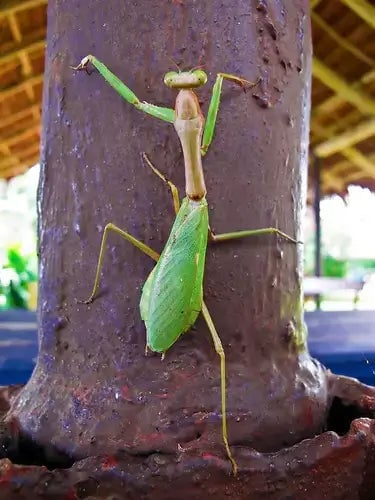10 Fascinating Facts About The Praying Mantis
With its distinctive posture and predatory behavior, the praying mantis is a captivating insect that has intrigued scientists and nature enthusiasts for centuries. These remarkable creatures are known for their unique characteristics and behaviors that set them apart from other insects. Here are ten fascinating facts about the praying mantis that illuminate their intriguing world.
1. Camouflaged Predators: Praying mantises are masters of camouflage. Their bodies often resemble leaves, sticks, or flowers. This camouflage helps them ambush unsuspecting prey without detection and protects them against predators.
2. Distinctive Hunting Pose: One of the most iconic features of the praying mantis is its characteristic hunting pose. They hold their front legs folded, resembling hands clasped in prayer—hence their name. This posture is used to catch prey and is a defining trait that makes them easily recognizable.
3. Predatory Behavior: Praying mantises are carnivorous insects known for their exceptional hunting skills. They primarily feed on insects like flies, crickets, grasshoppers, and other tiny mantises. When potential prey comes within reach, the mantis strikes with lightning speed, using its sharp forelegs to grasp and immobilize the victim. It then devours the game alive.
4. 3D Vision: Praying mantises have a remarkable vision that sets them apart from many other insects. They possess stereoscopic vision, which means their two large compound eyes work together to provide a sense of depth perception. This sophisticated visual system helps them accurately judge distances when striking at their prey.
5. Extraordinary Neck Flexibility: The praying mantis is known for its incredible neck flexibility. Unlike humans with limited neck movement, mantises can rotate their heads up to 180 degrees. This unique ability enables them to scan their surroundings for potential threats or prey without moving their bodies.
6. Cannibalistic Mating Behavior: While mating in the animal kingdom can often be delicate, praying mantises exhibit a rather brutal approach. In many species, the female mantis engages in cannibalism by consuming the male after or even during mating. While this behavior isn't universal, it highlights these insects' complex reproduction and survival strategies dynamics.
7. Incomplete Metamorphosis: Praying mantises undergo incomplete metamorphosis, which means their life cycle consists of three stages: egg, nymph, and adult. Unlike insects that go through complete change, such as butterflies, mantises hatch from eggs as nymphs that resemble miniature versions of the adults. They gradually molt and grow through a series of stages until reaching adulthood.
8. Aerial Acrobats: Some mantis species are skilled fliers capable of aerial acrobatics. Their wings allow them to move through the air for food or suitable habitats. However, not all mantises can fly, as wing development varies between species. Those who pass have a distinctive flight pattern that adds to their overall mystique.
9. Echolocation Defense: To fend off bat predators, some species of mantises have developed an intriguing defense mechanism—echolocation. These mantises can detect the ultrasonic calls of bats, which are usually used for navigation and hunting, and respond by ceasing all movement to avoid detection. This unique behavior showcases the evolutionary arms race between predators and prey.
10. Varied Habitats and Distribution: Praying mantises exist everywhere except Antarctica. They inhabit many ecosystems, from tropical rainforests to temperate grasslands and deserts. Their adaptability to diverse environments is a testament to their success as predators and ability to exploit various food sources. One of the most captivating aspects of the praying mantis is its extraordinary body structure.
The mantis possesses elongated thoraxes that allow its distinctive triangular head to rotate 180 degrees, providing an unparalleled range of vision. This adaptability enables it to track and ambush prey with exceptional accuracy. Its specialized forelegs, equipped with serrated spines, are a testament to nature's evolutionary artistry. These legs ensnare and hold onto victims, showcasing an unparalleled predatory adaptation.
Beyond its anatomy, the praying mantis exhibits diverse behaviors that intrigue scientists
Perhaps the most renowned is its mating ritual, where the female occasionally consumes the male after copulation. This act of sexual cannibalism, while seemingly counterproductive, may provide the female with essential nutrients to support egg production. Such behaviors highlight the intricacies of natural selection and reproductive strategies that underlie the insect world. In the grand tapestry of ecosystems, the praying mantis is vital in controlling insect populations.
Its voracious appetite for pests such as aphids, flies, and other mantises helps maintain ecological balance. Farmers and gardeners recognize its ecological contribution, often encouraging the presence of mantises as a natural form of pest control. Studying the praying mantis also has broader implications. Its exceptional camouflage abilities and hunting techniques have inspired technological advancements in robotics and optics.
Researchers draw inspiration from its visual acuity and stealthy movements to develop innovative solutions for various fields, including surveillance and medical imaging.
The praying mantis stands as a miniature marvel, offering a window into the complexities of the insect realm.
Its physical adaptations, intriguing behaviors, and ecological significance make it a fascinating subject of study.
By delving into the world of mantises, scientists and enthusiasts glean insights that extend far beyond the insect world, expanding our understanding of evolution, behavior, and the interconnections within nature. The praying mantis is a remarkable insect with many captivating traits and behaviors.
From their impressive camouflage and hunting techniques to their unique mating behaviors and sophisticated vision, these creatures amaze researchers and nature enthusiasts alike. Studying the intricacies of the praying mantis provides valuable insights into the complex world of insects and the web of interactions that shape our natural ecosystems.
Southern Blooms That Praying Mantises Adore
Well, honey, if you're from down South like me, you know a praying mantis is one of the best little critters to have in your garden. These fellas aren't just fascinating to watch with their slow, thoughtful movements; they're also incredible pest controllers. They'll gobble up all sorts of nuisances like aphids, beetles, and caterpillars. But let me tell you, to keep these garden guardians happy, you must plant flowers they adore.
First up, we've got marigolds. These fiery blooms, yellows, and oranges are like a big ol' neon sign for a praying mantis, inviting them to set up shop. The dense foliage provides shade, and the flowers attract plenty of the bug's mantises to snack on. You'll often spot one perched right there, looking like it owns the place.
Then there's the cosmos, with its wispy leaves and delicate blooms swaying in the breeze. These flowers are the definition of Southern charm. Mantises love hiding in their feathery greenery, waiting for the perfect opportunity to pounce. And who could blame them? Cosmos are a sight to behold, magnets for pollinators and other insects. Now, don't forget zinnias, darlin'. These bright and bold flowers are like a buffet line for beneficial insects. They attract everything from bees to butterflies, bringing in the mantises. Plus, zinnias thrive in that good ol' Tennessee sun, making them a breeze to grow.
Another favorite is the classic daisy. Whether the humble oxeye or a fancier Shasta variety, daisies are simple yet stunning. Their open blooms make it easy for mantises to spot their next meal. If you're lookin' to keep your garden full of life, a few patches of daisies will do just the trick.
Lastly, let's talk about goldenrod, that beautiful wildflower with its tall, golden plumes. It's perfect for the back of a garden bed or along a fence line. Mantises are drawn to the smorgasbord of insects goldenrod attracts. And don't you worry about the rumors-goldenrod doesn't cause allergies; that's ragweed's job.
So, sweet pea, if you want to roll out the red carpet for a praying mantis, give them a garden full of these blooms. They'll repay you by keeping your plants pest-free and adding magic to your slice of Southern paradise. There's nothing quite like a mantis keeping watch over your flowers, is there?
Attracting (or Deterring) Praying Mantises with Garden Plants
1. Why Praying Mantises Are Beneficial
Many gardeners view praying mantises so positively that their benefits should be highlighted before exploring plant options. During its life span, a praying mantis eats many insects, such as aphids, beetles, flies, caterpillars, and grasshoppers, which attack ornamental plants and crops. Attracting mantises helps establish natural pest control, which diminishes or removes the need for chemical sprays. Mantis populations signal a healthy and biodiverse environment because they require stable food sources and proper shelter to flourish.
2. Plants That Praying Mantises Love
Mantises do not eat plants but use vegetation to protect them from predators, egg-laying sites, and hunting grounds. The following sections list general plant categories which attract praying mantises.
Dense, Foliage-Rich Plants
Mantises choose habitats packed with leaves and stems to camouflage themselves while hunting prey. Plants with dense branching or bushy growth patterns are ideal options. Mantises require shrubs, ornamental grasses, and herbaceous perennials that maintain full leaf growth. Dense vegetation helps mantises find safe places to hide and hunt without being easily seen by predators.
Pollinator-Friendly Blooms
Praying mantises seek locations with abundant prey, typically areas frequented by pollinators, even though they do not consume nectar or pollen. Flowers that draw bees and butterflies, as well as other insects, serve as indirect magnets for mantises by providing consistent access to food. Examples include many common garden flowers with easily accessible nectar: Bright composite flowers alongside tubular varieties and small-blossom clusters serve as prime examples. Mantises prioritize locations with abundant insect activity over specific plant species because they instinctively move toward busy feeding stations.
Herbaceous Borders and Meadow Gardens
Mantises find abundant hunting opportunities in garden settings that combine cottage-style plantings with diverse plant heights and textures. Ornamental grasses alongside wildflowers and pollinator-attractive plants sustain elevated insect numbers. Mantises use plants as elevated platforms to sit patiently until prey creatures pass by. Mantises prosper in less manicured garden spaces that permit natural diversity instead of extremely tidy lawns with minimal plant variety.
Plants That Host Soft-Bodied Insects
Praying mantises consume aphids, caterpillars, and additional soft-bodied insect species. You may want to avoid pests, but maintaining a small number of aphid-prone plants, such as specific ornamental species or residual weeds at your garden's border, helps nourish mantises. These "pest hubs" function as food sources that maintain mantises in your garden because they offer dependable meals.
3. Plants and Conditions That May Repel Mantises
Plants do not automatically "repel" mantises like citronella repels mosquitoes. Your garden can become less attractive due to specific contributing factors.
Highly Aromatic or Pungent Herbs
Herbs with intense fragrances, such as mints and alliums, are natural repellents for insects like aphids and beetles. Mantises will leave areas where their prey species are nonexistent. These plants drive mantises away because they reduce insect numbers, though they don't directly repel or poison mantises.
Note: Gardeners have noticed that mantises avoid areas with intensely pungent plants. These plants irritate them and disrupt the chemical signals they rely on to find prey. Research hasn't scientifically validated this observation yet, but pay attention to it if mantises shun beds with strong fragrances.
Plants Treated with Insecticidal Chemicals
Garden areas treated with broad-spectrum insecticides (whether synthetic or natural) will kill pest insects but also potentially harm mantises or remove their food sources. Beneficial insects will leave an area if they find no prey or if they get injured by leftover chemicals. The more you use chemical sprays, the fewer praying mantises you will find.
Heavily Pruned, Minimalist Gardens
Mantises find few hiding spots and prey in manicured gardens due to their sparse ground cover, minimal plant layering, and limited insect diversity. Mantises will struggle to locate adequate hiding and hunting spots in gardens with significant lawn stretches and limited planting beds. The result is fewer mantises over time.
Monocultures
Fields or gardens that contain only one plant species tend to experience pest outbreaks while maintaining minimal biodiversity. Monocultures sometimes result in pest outbreaks that temporarily draw mantises, but they require extensive pesticide applications and regular mechanical disturbances, which pose lethal risks or significant disruptions to mantis populations. Maintaining multiple habitats with different prey sources is essential to sustain mantis populations.
4. Encouraging a Mantid-Friendly Habitat
Create a balanced ecosystem to ensure mantises stay in your area instead of departing.
Diversify Plantings: Plant pollinator-attracting annuals with perennials alongside ornamental grasses and shrubs together with groundcover species. Different plant characteristics, such as shape, texture, and bloom periods, maintain ongoing insect activity.
Reduce Pesticides: Opt for agricultural practices such as crop rotation and hand pest removal instead of chemical sprays, which destroy damaging and helpful insects.
Allow Natural Shelter: Maintain some garden sections in a slightly disordered state or apply thick mulch layers to provide spaces for mantises to deposit their egg cases and establish safe havens.
Observe and Adjust: Regularly walk through your garden to monitor insect populations and observe mantis activity. Mimic the conditions from where mantises congregate to replicate them in other areas.
Praying mantises do not exhibit the same avoidance behavior towards specific plants as some insects when encountering strong herbal smells. Still, they will relocate if they cannot find adequate habitat or food sources. The combination of thick vegetation, abundant insect life, pollinators, soft-bodied pests, and limited pesticide use forms an attractive habitat. Selecting a diversity of plants that attract pollinators and resemble shrubs helps you build the necessary biodiversity for mantises to establish themselves. Heavily aromatic or chemically treated gardens result in fewer insects, creating an unattractive environment where mantises can stay. Creating harmony between your garden design and maintenance practices will ensure you can enjoy beneficial predator insects.
Read more

TN Nursery was voted the #1 mail order nursery of 2022 We are thankful for our heritage in the nursery industry. We will continue as we have for over half a century to provide you with quality plan...

You can eat and grow them, but what else can you do with a nut? You can carve it! The delicate art of nut carving is practiced in China and found in many other places.


